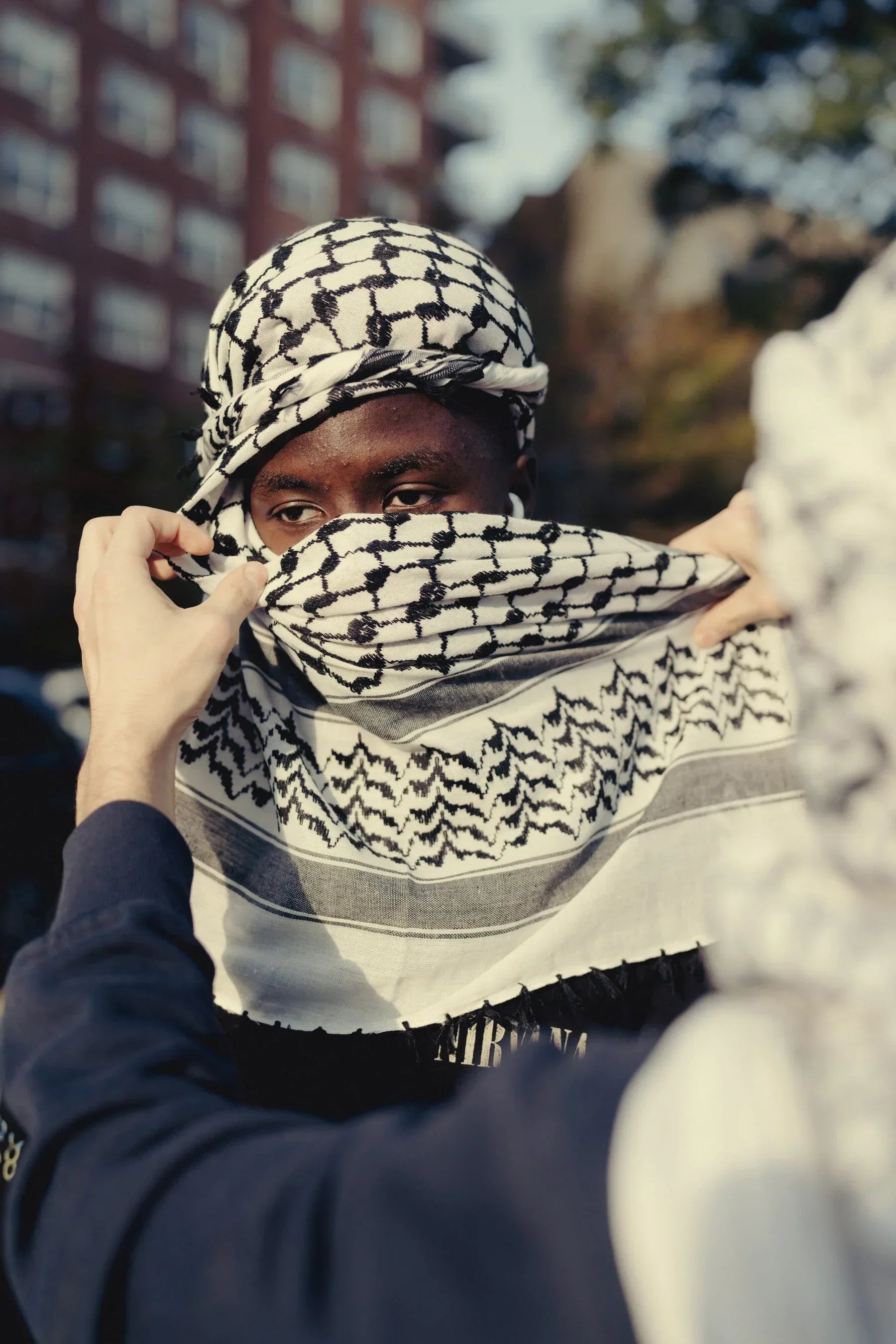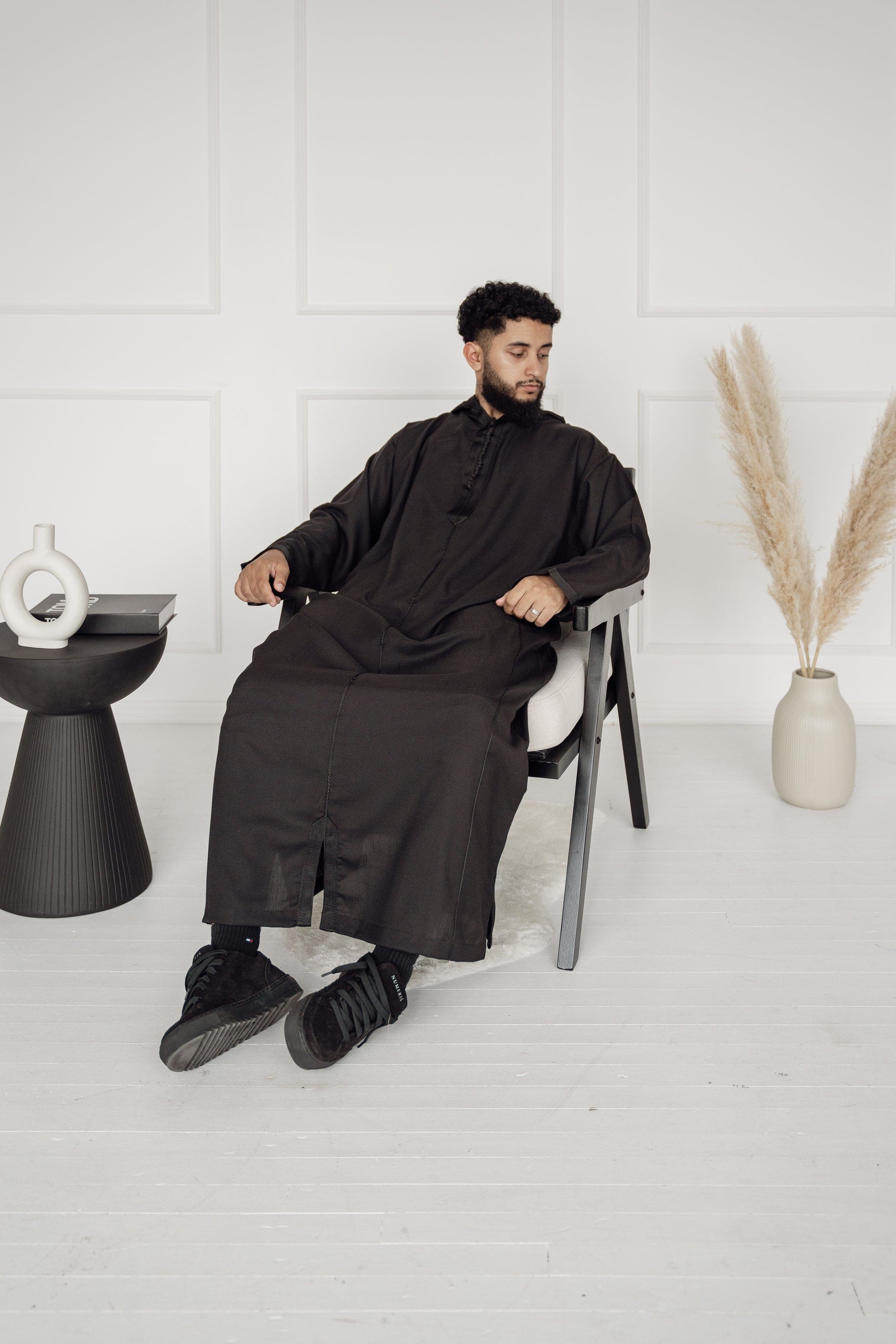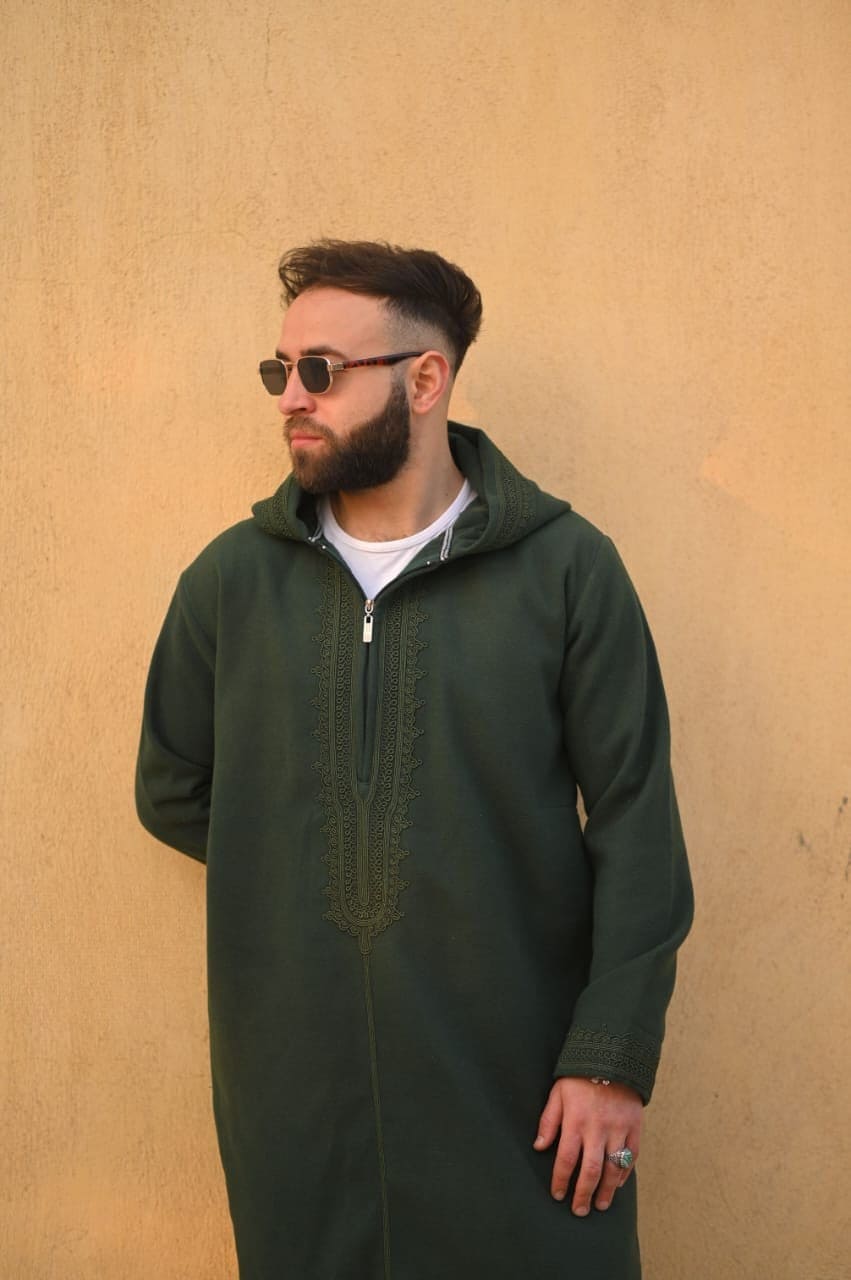The Palestinian keffiyeh is far more than a fashion accessory. It's a powerful symbol of identity, resistance, and cultural heritage. Whether you're wearing it to show solidarity with Palestine, express your heritage, or protect yourself from the elements, knowing how to wear a keffiyeh properly demonstrates respect for its deep cultural significance.
This comprehensive guide will teach you multiple ways to tie and style your Palestinian keffiyeh, from traditional wraps to modern casual looks. Each style carries its own meaning and purpose.
What is a Palestinian Keffiyeh?
The Palestinian keffiyeh (also spelled kufiya, hatta, or shemagh) is a traditional square cotton scarf, typically measuring 110cm x 110cm. The iconic black and white checkered pattern is instantly recognizable worldwide as a symbol of Palestinian identity and resistance.
Key features of an authentic Palestinian keffiyeh:
- Classic black and white checkered pattern
- Fishnet weave representing connection to the Mediterranean Sea
- Olive leaf designs symbolizing resilience and attachment to the land
- Bold lines representing historic trade routes through Palestine
- 100% cotton or cotton-blend fabric for breathability
Unlike mass-produced imitations, authentic keffiyehs from Palestinian manufacturers like the Hirbawi factory in Hebron are made with traditional techniques passed down through generations.
Why Wear a Palestinian Keffiyeh?
People wear the Palestinian keffiyeh for many reasons:
Cultural Expression: For Palestinians, wearing the keffiyeh connects them to their heritage, ancestors, and homeland. It's a wearable piece of history that carries generations of meaning.
Political Solidarity: Non-Palestinians wear the keffiyeh to show support for Palestinian rights, liberation, and self-determination. It's a visible statement of solidarity.
Practical Protection: The keffiyeh's original purpose still holds. It protects against sun, wind, sand, dust, and cold weather, making it ideal for outdoor activities.
Fashion & Style: When worn with understanding of its significance, the keffiyeh adds cultural depth and bold style to any outfit.
Important Note: If you're not Palestinian, wearing the keffiyeh carries responsibility. Understand its history, support Palestinian manufacturers, and be prepared to speak about Palestinian rights. This isn't cultural appropriation when done with genuine solidarity and respect; it's an act of political support.
Essential Keffiyeh Styling Tips
Before learning specific tying techniques, keep these styling principles in mind:
1. Choose Authentic Keffiyehs Support Palestinian artisans by purchasing from manufacturers like Hirbawi. Authentic keffiyehs are made in Palestine with traditional methods and directly support Palestinian communities.
2. Respect the Symbolism The black and white pattern isn't just aesthetic. Each element has meaning. Wear it with awareness of what it represents.
3. Coordinate Your Outfit
- Pair with neutral colors (black, white, grey, olive) for a cohesive look
- Layer with denim jackets, leather, or casual streetwear
- Keep other accessories minimal to let the keffiyeh be the statement piece
4. Consider the Occasion
- Protests and demonstrations: Traditional or tactical wraps
- Casual daily wear: Neck scarf or shoulder wrap styles
- Outdoor activities: Full head and face coverage for protection
- Cultural events: Traditional draping styles
5. Proper Fabric Care
- Hand wash in cold water with mild detergent
- Air dry flat to maintain shape
- Avoid harsh chemicals that damage cotton fibers
- Iron on low heat if needed
How to Tie a Keffiyeh: Basic Foundation
Every keffiyeh style starts with the same basic fold. Master this technique first:
Step 1: Lay the keffiyeh flat in a square shape
Step 2: Fold it diagonally to create a triangle, ensuring all corners align perfectly
Step 3: Hold the folded edge (the longest side) in both hands
This triangular shape is your foundation. From here, you can create multiple different styles depending on how you position and wrap it.
5 Popular Ways to Wear a Palestinian Keffiyeh
1. Traditional Palestinian Head Wrap (Arafat Style)
This is the most iconic way to wear the keffiyeh, popularized by Yasser Arafat. He famously draped it over his right shoulder in the shape of historic Palestine.
How to tie:
- Fold the keffiyeh into a triangle
- Place the folded edge across your forehead, letting the point hang down your back
- Take one end and drape it over your right shoulder (Arafat draped it to resemble Palestine's map)
- Bring the other end across your chest and over the left shoulder
- Adjust so the drape feels secure and comfortable
When to wear: Cultural events, demonstrations, formal occasions where you want to honor Palestinian tradition
Cultural note: This style carries the most political weight. It's a direct visual reference to Palestinian liberation and Arafat's legacy.
2. Tactical Face and Neck Wrap (Full Coverage)
This practical style provides maximum protection against weather elements. It's popular with outdoor enthusiasts and at protests where tear gas or dust may be present.
How to tie:
- Fold the keffiyeh into a triangle
- Place the folded edge under your eyes, covering your nose and mouth
- Bring both ends around the back of your head
- Tie them securely at the back or bring them forward and tie under your chin
- Adjust the fabric over your face for comfort and breathability
When to wear: Protests, desert/dusty environments, cold weather, outdoor activities
Practical benefits: Protects against sand, dust, wind, cold air, and sun exposure. Provides anonymity at demonstrations if needed.
3. Neck Scarf Style (Everyday Casual)
The most approachable style for daily wear. Simple, comfortable, and stylish without full head coverage.
How to tie:
- Fold the keffiyeh into a triangle
- Drape it around your neck with the point hanging down your chest
- Cross the two ends behind your neck
- Bring them forward and tie loosely at the front, or let them hang naturally
- Adjust the point in front to your desired length
When to wear: Everyday casual wear, running errands, social gatherings, adding style to basic outfits
Styling tips:
- Works great with t-shirts, hoodies, and denim jackets
- Layer over leather jackets for an edgier look
- Pair with simple jewelry for added personal style
4. Shoulder Shawl Wrap (Elegant & Warm)
This graceful style works as a shawl or light wrap, perfect for cooler evenings or adding dramatic flair to your outfit.
How to tie:
- Fold the keffiyeh into a triangle
- Drape it over your shoulders like a shawl, with the point hanging down your back
- Let the two ends hang naturally in front
- Optional: tie the ends loosely in front or use a brooch to secure it
When to wear: Cool evenings, indoor events, adding layers to outfits, elegant casual occasions
Styling benefits: Provides warmth without bulk, adds visual interest to simple outfits, easy to remove when indoors
5. Bedouin/Desert Style (Full Head Protection)
This traditional Middle Eastern style offers complete sun and sand protection. It's the original way Bedouins and Palestinian farmers wore the keffiyeh.
How to tie:
- Fold the keffiyeh into a triangle
- Place it over your head with the point hanging down your back
- The folded edge should sit across your forehead just above your eyebrows
- Use an agal (black rope headband) to secure it on your head, or tie the ends
- You can pull fabric forward to cover your face when needed
When to wear: Desert environments, extreme sun exposure, authentic cultural expression, outdoor adventures
Cultural significance: This is how Palestinian farmers wore it for centuries. It's the most historically accurate style and shows deep respect for the keffiyeh's practical origins.
Modern Styling Variations
The Loose Drape
Simply drape the unfolded or loosely folded keffiyeh around your neck, letting it hang naturally. This casual, effortless look works well with streetwear.
The Infinity Loop
Fold the keffiyeh lengthwise into a long strip, wrap it around your neck twice, and tuck the ends. Creates a cozy, layered look.
The Asymmetric Wrap
Drape the keffiyeh over one shoulder only, letting one end hang longer than the other. Edgy and fashion-forward.
The Belt Accent
Wear the keffiyeh around your neck and secure it with a belt around your waist. Creative styling that works with long coats or jackets.
Keffiyeh Styling for Different Body Types
Petite frames: Fold the keffiyeh smaller or use a child-sized version (available in some shops). Avoid overwhelming your frame with too much fabric.
Tall/larger frames: The standard 110cm keffiyeh works perfectly. You can even layer two keffiyehs for extra warmth and visual impact.
All body types: The key is adjusting the tightness and positioning. The keffiyeh should feel secure but not restrictive.
Accessories to Pair with Your Keffiyeh
Agal (Traditional Black Rope): Authentic way to secure head wraps. Purchase from Middle Eastern specialty shops or online retailers.
Pins and Brooches: Palestinian flag pins, olive branch designs, or simple decorative pins can secure shawl-style wraps.
Sunglasses: Classic aviators or wayfarers complement the keffiyeh's bold pattern.
Jewelry: Keep it simple. Silver or brass pieces work well. Consider Palestinian-made jewelry to support artisans.
Hats: Some people layer keffiyehs under wide-brimmed hats for extra sun protection.
Common Keffiyeh Wearing Mistakes to Avoid
1. Wearing it as "just fashion" without understanding its meaning. Always know what you're wearing and be ready to speak about Palestinian solidarity.
2. Buying cheap Chinese knockoffs instead of supporting Palestinian manufacturers. Your purchase matters.
3. Wearing it with Israeli symbols or imagery. This is deeply disrespectful to Palestinians.
4. Over-accessorizing. The keffiyeh is a statement piece. Let it speak without competing accessories.
5. Treating it carelessly. This is a cultural symbol with deep meaning. Handle it with respect.
Caring for Your Palestinian Keffiyeh
Proper care ensures your keffiyeh lasts for years:
Washing:
- Hand wash in cold water whenever possible
- Use mild, gentle detergent (avoid harsh chemicals)
- Avoid wringing or twisting the fabric
- If machine washing, use delicate cycle in a mesh bag
Drying:
- Air dry flat or hang to dry
- Avoid direct sunlight which can fade the black dye
- Never use a dryer (high heat damages cotton fibers)
Storage:
- Fold neatly and store in a drawer or hang on a hook
- Keep away from moisture to prevent mildew
- Consider a cedar block to protect from moths
Maintenance:
- Iron on low heat if wrinkled (cotton can handle heat)
- Repair small tears immediately to prevent spreading
- The fabric will soften with age, making it even more comfortable
Where to Buy Authentic Palestinian Keffiyehs
Support Palestinian Manufacturers:
Hirbawi Factory (Hebron, Palestine): The last remaining keffiyeh factory in Palestine. Founded in 1961, they use traditional cotton-only weaving methods. Purchase directly supports Palestinian workers and preserves this endangered craft.
Palestinian-owned shops: Look for retailers that explicitly state their keffiyehs are made in Palestine or by Palestinian artisans.
Fair trade organizations: Some fair trade groups work directly with Palestinian cooperatives.
What to avoid:
- Mass-produced Chinese versions (they undercut Palestinian manufacturers)
- Fashion brands that appropriate the design without supporting Palestinians
- Retailers that can't verify the keffiyeh's origin
Price guidance: Authentic Palestinian keffiyehs typically cost $15-$40. If it's cheaper, it's likely not authentic. If it's much more expensive (like designer versions at $700+), you're paying for brand name, not Palestinian artisans.
The Political Statement of Wearing a Keffiyeh
Wearing a Palestinian keffiyeh is inherently political. There's no way around it. This isn't a neutral fashion choice. It's a statement of solidarity with Palestinian liberation.
What wearing it communicates:
- Support for Palestinian self-determination
- Recognition of Palestinian history and ongoing struggle
- Opposition to occupation and displacement
- Solidarity with oppressed peoples globally
Be prepared for:
- Questions about why you're wearing it
- Political discussions and debates
- Potential criticism from pro-Israel advocates
- Opportunities to educate others about Palestine
Your responsibility as a wearer:
- Learn Palestinian history and current reality
- Support Palestinian voices and leadership
- Speak up when you witness anti-Palestinian rhetoric
- Direct people to Palestinian sources and organizations
- Never speak over or for Palestinians; amplify their voices
Keffiyeh Etiquette and Cultural Sensitivity
Do:
- ✅ Learn about Palestinian history before wearing it
- ✅ Buy from Palestinian sources when possible
- ✅ Explain its significance if asked
- ✅ Wear it to protests and solidarity actions
- ✅ Treat it with respect and care
- ✅ Listen to Palestinian voices about appropriate use
Final Thoughts: Wear It With Purpose
The Palestinian keffiyeh is woven with over a century of resistance, resilience, and refusal to be erased. Every time you wear it, you're carrying that history. You're making visible a struggle that many try to silence.
Whether you drape it over your shoulder like Arafat, wrap it around your face at a protest, or wear it casually as a daily reminder of Palestinian liberation, do it with intention. Do it with knowledge. Do it with solidarity that extends beyond the fabric.
The keffiyeh is more than a styling choice. It's a commitment to justice. Wear it proudly. Wear it purposefully. And most importantly, wear it in genuine support of the Palestinian people's fight for freedom, dignity, and return to their homeland.
Palestine will be free. And the keffiyeh will be there when it happens.



